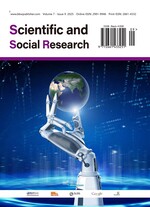A Study on Innovative Approaches to Using Sensory Integration Toys in Nursery Schools from a Play Perspective
Abstract
Sensory integration training, as a vital educational method for promoting the coordinated physical and mental development of young children, has garnered significant attention in the field of early childhood education in recent years. Traditional sensory integration toys predominantly consist of standardized, functional equipment, whose usage is often confined to predetermined rules and fixed procedures, making it challenging to fully stimulate children’s autonomy and creativity. This paper adopts a “play perspective” to explore innovative approaches to using sensory integration toys in kindergartens. It advocates integrating sensory integration training into free, open, and imaginative play activities to enhance the enjoyment, contextual relevance, and individual adaptability of sensory integration education. Through literature analysis, case studies, and educational observations, the paper proposes four innovative application models: “play-based reconstruction”, “cross-domain integration”, “role-driven engagement”, and “environmental creation.” These models are validated within practical teaching contexts. Findings indicate that employing sensory integration toys through a play-based approach not only effectively enhances children’s sensory integration abilities but also fosters their social skills, creativity, and problem-solving capabilities. Finally, this paper offers optimization recommendations, providing kindergarten teachers with actionable teaching strategies to advance sensory integration education towards a more humanistic and child-centered approach.
References
Ayres AJ, 1979, Sensory Integration and the Child. Western Psychological Services, Los Angeles.
Huang RS, 2015, Preschool Education (3rd ed.). People’s Education Press, Beijing.
Wang P, 2020, Current Status and Optimization Pathways of Sensory Integration Training in Kindergartens. Preschool Education Research, 2020(3): 45–50.
Zhang LS, 2018, Causes and Intervention Strategies for Sensory Integration Disorders in Children. Chinese Journal of Special Education, 2018(5): 67–72.
Gao XM, 2021, An Experimental Study on the Effects of Sensory Integration Training on Young Children’s Attention. Psychological Development and Education, 37(2): 231–238.
Li H, 2019, An Applied Study of Gamified Teaching in Kindergartens. Educational Exploration, 2019(8): 88–92.
Piaget J, 1962, Play, Dreams and Imitation in Childhood. W. W. Norton & Company, New York.
Vygotsky LS, 1978, Mind in Society: The Development of Higher Psychological Processes. Harvard University Press, Harvard.
Rubin KH, Fein GG, Vandenberg B, 1983, Play, in Handbook of Child Psychology (Vol. 4, pp. 693–774). Wiley, New York.
Chen HQ, 1984, Collected Educational Writings of Chen Heqin (Volume 2). Beijing Publishing House, Beijing.
Ministry of Education, 2012, Guidelines for Learning and Development of Children Aged 3–6. Official Website of the Ministry of Education of China.
Zhou J, 2017, Children’s Language Development and Education. East China Normal University Press, Shanghai.
Yu Y, 2020, Theory and Practice of Kindergarten Curriculum Development. Nanjing Normal University Press, Nanjing.
Feng X, 2019, Organization and Guidance of Play Activities in Kindergartens. Beijing Normal University Press, Beijing.
Zhu J, 2016, Preschool Education Curriculum. East China Normal University Press, Shanghai.
Lin YH, 2014, Child Psychology and Education. East China Normal University Press, Shanghai.
Shen QF, 2022, Application of Gamified Learning in Kindergarten Physical Activities. Early Education, 2022(4): 33–36.
Dong XH, 2021, Organization and Implementation of Zone Activities in Kindergartens. Shandong University Press, Shandong.
Qiu XQ, 2020, Play in Preschool Children (Fifth Edition). Nanjing Normal University Press, Nanjing.

